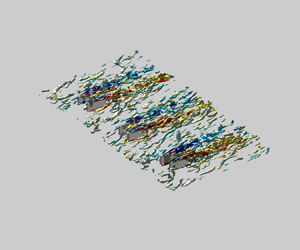Article contents
Investigation of the influence of miniature vortex generators on the large-scale motions of a turbulent boundary layer
Published online by Cambridge University Press: 07 December 2021
Abstract

Well resolved large-eddy simulation data are used to study the physical modulation effects of miniature vortex generators (MVGs) in a moderate Reynolds number zero pressure gradient turbulent boundary layer. Large-scale counter-rotating primary vortex pairs (PVPs) imposed by the MVG contribute to the formation of streamwise streaks by transporting high momentum fluids from the outer regions of the boundary layer towards the wall, giving rise to high-speed regions centred at the PVP. Consequently, low-speed regions are formed along the outer flank of the PVP, resulting in a pronounced alternating high- and low-speed flow pattern. The PVP also relates to regions with skin friction modification, where a local skin friction reduction of up to 15 % is obtained at the low-speed region, but the opposite situation is observed over the high-speed region. The MVG-induced flow feature is further investigated by spectral analysis of the triple decomposition velocity fluctuation. Pre-multiplied energy spectra of the streamwise MVG-induced velocity fluctuation reveal that the large-scale induced modes scale with the spanwise wavelength and the length of the MVG, but the energy peak is eventually repositioned to the size of the near-wall streaks in the streamwise direction. Analysis of the triple decomposition of the kinetic energy transport equations revealed the significance of the mean flow gradient in generating kinetic energy which sustains the secondary motion. There is also an energy transfer between the turbulent and MVG-induced kinetic energy independent of the mean flow.
JFM classification
- Type
- JFM Papers
- Information
- Copyright
- © The Author(s), 2021. Published by Cambridge University Press
References
REFERENCES
- 7
- Cited by



